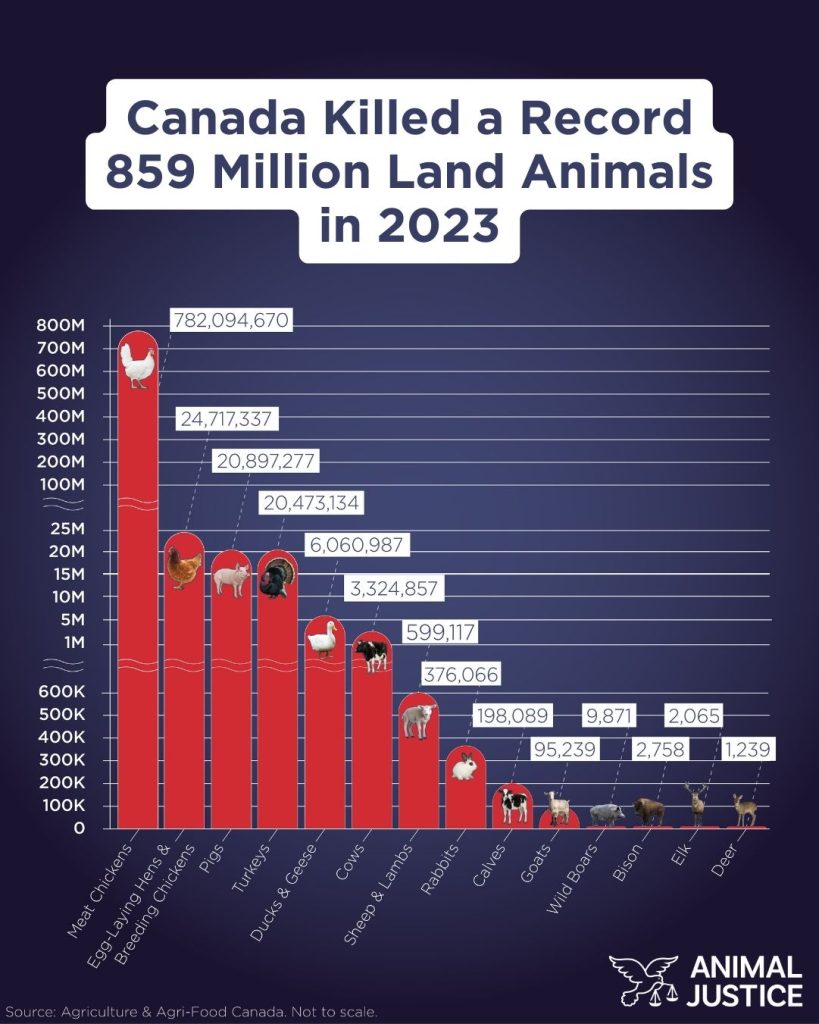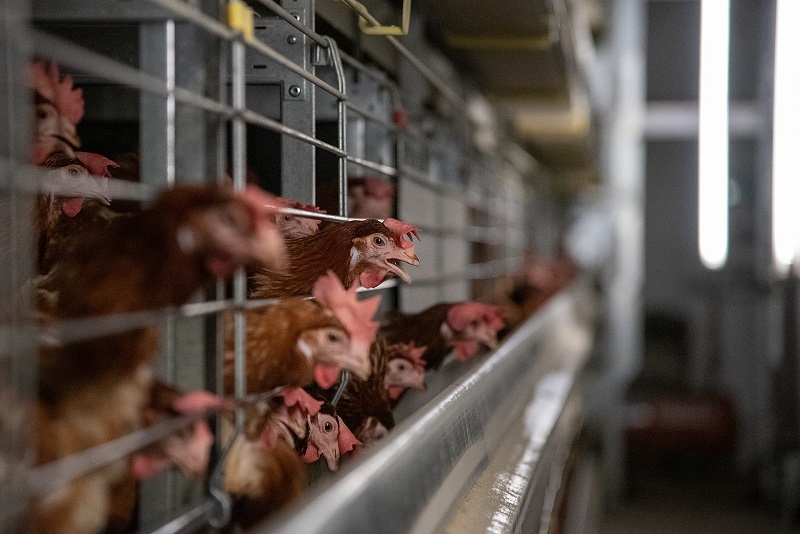Animal slaughter is increasing in Canada at a disturbing rate. New government statistics show that in 2023, nearly 859 million land animals were killed for food, making it the deadliest year on record since Animal Justice began analyzing government slaughter statistics.
The number of cows, pigs, chickens and other animals slaughtered for food typically increases by millions of animals every year. The vast majority of these animals were raised in cruel factory farms—dark, filthy, and overcrowded warehouses where animals have little ability to engage in natural behaviours. These sensitive creatures endured heartbreaking suffering in these facilities, a grueling journey in transport to the slaughterhouse, and a violent death.

The 2023 number of animals killed has increased from:
The number of animals slaughtered for food in 2020 and 2021 dipped due to disruptions caused by the pandemic. Sadly, the death toll has continued to grow dramatically since then.
Why Are More Animals Being Killed Every Year?
There are two main reasons why slaughter rates keep increasing: human population growth and growing demand for chicken meat.
In recent years, there has been a trend towards eating more meat from chickens. Chickens are much smaller animals than cows or pigs, which means more animals suffer and die when people switch from eating cows and pigs (red meat) to chickens (white meat). In 2023 versus 2022, over 15 million more chickens were killed.
Tragically, chickens endure some of the worst suffering in the agriculture industry. Chickens used for meat are bred to grow so abnormally large that their lives are full of pain, with their bodies often collapsing under their enormous weight. Meanwhile, hens used for egg production are still mostly confined in cramped wire cages for the duration of their miserable lives.
Animals Killed Broken Down by Species
- Meat chickens: 782,094,670
- Egg-laying hens & breeding chickens: 24,717,337
- Pigs: 20,897,277
- Turkeys: 20,473,134
- Ducks & geese: 6,060,987
- Adult cows (dairy & meat): 3,324,857
- Sheep & lambs: 599,117
- Rabbits: 376,066
- Calves: 198,089
- Goats: 95,239
- Wild boars: 9,871
- Bison: 2,758
- Elk: 2,065
- Deer: 1,239
TOTAL: 858,852,706


These numbers only account for land animals who were slaughtered and entered the food supply, and don’t paint a full picture of the vast scale of animal suffering and death in agriculture.
Many more animals die on farms or during transport, including male chicks who are ground up alive as “waste” at hatcheries. In 2023, 13,962,000 chicks were macerated in egg hatcheries, 5,535,000 were killed in meat chicken hatcheries, and 752,000 turkey chicks were killed.
Billions more aquatic animals such as fishes, lobsters, crabs, and clams are killed for food. Government statistics measure their lives by weight, not as individuals, but Animal Justice’s own calculations show that over 10 billion aquatic animals are likely killed every year in Canada.
The government currently refuses to release the number of horses who are slaughtered in Canada for meat, unfairly shielding the horse meat industry from scrutiny. The last year this data was available was 2016, which saw 54,000 horses slaughtered, and some independent analyses list Canada as the sixth largest exporter of horse meat in the world.


No Laws for Farmed Animals
The enormity of animal suffering for food is difficult to fathom. These animals not only face a violent death, but the vast majority are condemned to lives of sheer misery and suffering in factory farms.
Standard farming practices, which include painful mutilations and locking animals in tiny cages, are exempt from general animal protection laws. Instead of legally-binding standards of care for animals on farms, the farmers are allowed to make up their own rules for animal treatment. The industry creates voluntary codes of practice through the National Farm Animal Care Council (NFACC), with no independent enforcement or public verification mechanisms.
At Animal Justice, we believe animals need lawyers. Animals on farms deserve laws and inspections to ensure those laws are being followed. Our legal team has made it their mission to overhaul the legal system to protect animals from the widespread cruelty and neglect that they endure. Please join our compassionate community and help make real, lasting change in the lives of animals.
Banner: Jo-Anne McArthur | We Animals Media
